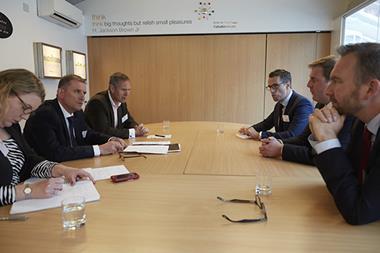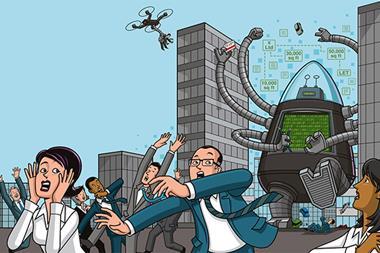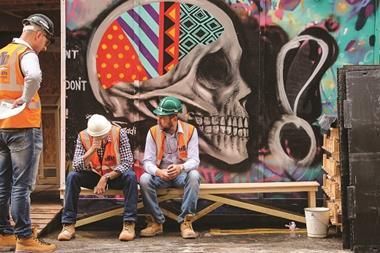A short time ago in a galaxy far, far away, the boffins at Balfour Beatty envisioned a brave new world for construction. Robots would build offices, buildings would build themselves and the few earthlings involved would be controlled by ‘exoskeletons’.

“The construction site of 2050 will be human-free,” states Innovation 2050: A Digital Future for the Infrastructure Industry, which was published in late June. Robots will work in teams to build complex structures using dynamic new materials.
Elements of the build will self-assemble. Drones will scan the site, instructing robotic cranes and diggers and automated builders with no need for human involvement.”
Are you ‘avin’ a larf? Apparently not: “The role of the human overseer will be to remotely manage multiple projects simultaneously, accessing 3D and 4D visuals. The very few people accessing the site will wear robotically enhanced exoskeletons and use neural-control technology to move and control machinery and other robots on site.”
Inspiring stuff. But isn’t this the same Balfour Beatty that lost £276m between 2013 and 2016 thanks to much more earthly failings?
Failings like bidding too low, screwing up costs and incurring late-delivery penalties. The company’s not at all alone in that regard, as evidenced in Carillion’s astronomical profit warning on 10 July, but most rivals have kept their heads down and no doubt saved a bob or two by avoiding futuristic navel-gazing.

This appears to bear the hallmarks of chief executive Leo Quinn, whose past management school-inspired quotes have included:
“Empowerment without measurement is abandonment.” One of Quinn’s central tenets since his arrival at Balfour Beatty in 2015 seems to be that you can nail down a similar analytical template on to any business, irrespective of its sector. To wit, digital innovation has transformed manufacturing and communications, so it can do the same with property and construction.
Somehow, I doubt it. There will be innovation, but it will continue to be incremental and cautiously adopted. Property and infrastructure clients pay the bills and they - not contractors - will call the shots. Conservatism runs through the sector’s DNA like a stick of rock, and for good reason: innovation is cyclical and often costly. Visionary new ideas - take for instance the 1990s mantra of ‘partnering’ - generally flourish in the white heat of booms only to be usurped by old-style lump-sum contracting in recessions. And you can’t save money by firing robots.
Star Wars reprogrammed
I don’t know if I’ll make it to 2050, but let’s just imagine robots do then rule construction sites. Star Wars’ two headlining droids could be reprogrammed by Balfour Beatty. C-3PO, in Le Corbusier glasses, would be a typically irascible architect; R2-D2 a recalcitrant builder…
“R2, I’m so excited. I’ve been commissioned to design smart buildings with self-healing materials in smart cities that are able to adapt instantly to changing circumstances.”
“What the bleep?”
“R2, you’re quite impossible. Construction will get faster, using 3D and 4D printing, according to Prediction 07 in Innovation 2050.”
“All right, but it’ll cost you.”
“Do not worry. The digitised BIM cost model has already assessed the cost: 800 Intergalactic Credits for each Earth day.”
“And the rest; 1,200, take it or leave it, sunshine. All the other droids are working for the Vogons on the Intergalactic Bypass.”
“This is quite irregular, quite irregular, quite…” Whirr, clang. “I can’t understand it, my circuits are malfunctioning. My exoskeleton arm is behaving erratically. I believe it’s been hacked.”
“Before it falls off completely, my CPU urgently needs an upload of tea. Two sugars, mate.”






























No comments yet